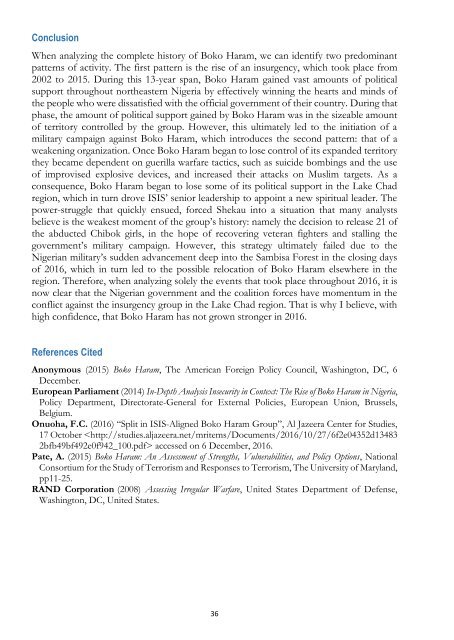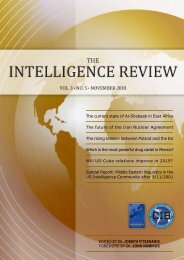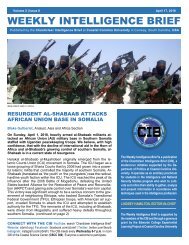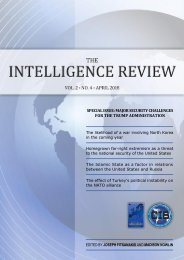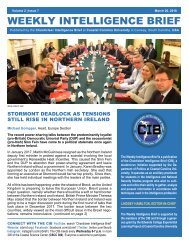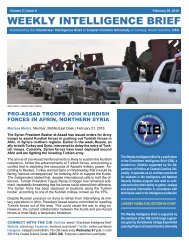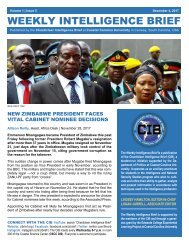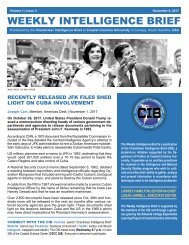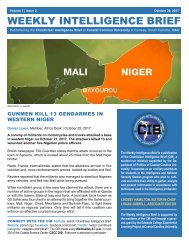The Intelligence Review | volume 1 | issue 2 |
This volume is the product of a collaboration between the European Intelligence Academy (EIA) and the Chanticleer Intelligence Brief (CIB), a student-run initiative supported by the Department of Politics at Coastal Carolina University in Conway, South Carolina, United States. Eleven CIB analysts tackle some of the most pressing and timely questions confronting intelligence observers today. Topics include the gun control debate in the United States, Russia’s involvement in the Syrian Civil War, the future of Kurdish nationalism, and the internal Palestinian dispute between Hamas and Fatah. Papers in this volume also examine the current state of Islamist extremism, and extrapolate on its future prospects in the Middle East, West Africa, the Lake Chad region, as well as in Southeast and Central Asia. CIB analysts propose carefully crafted and informed forecasts that outline future developments in some of the world's most unpredictable hot spots.
This volume is the product of a collaboration between the European Intelligence Academy (EIA) and the Chanticleer Intelligence Brief (CIB), a student-run initiative supported by the Department of Politics at Coastal Carolina University in Conway, South Carolina, United States. Eleven CIB analysts tackle some of the most pressing and timely questions confronting intelligence observers today. Topics include the gun control debate in the United States, Russia’s involvement in the Syrian Civil War, the future of Kurdish nationalism, and the internal Palestinian dispute between Hamas and Fatah. Papers in this volume also examine the current state of Islamist extremism, and extrapolate on its future prospects in the Middle East, West Africa, the Lake Chad region, as well as in Southeast and Central Asia. CIB analysts propose carefully crafted and informed forecasts that outline future developments in some of the world's most unpredictable hot spots.
- No tags were found...
Create successful ePaper yourself
Turn your PDF publications into a flip-book with our unique Google optimized e-Paper software.
Conclusion<br />
When analyzing the complete history of Boko Haram, we can identify two predominant<br />
patterns of activity. <strong>The</strong> first pattern is the rise of an insurgency, which took place from<br />
2002 to 2015. During this 13-year span, Boko Haram gained vast amounts of political<br />
support throughout northeastern Nigeria by effectively winning the hearts and minds of<br />
the people who were dissatisfied with the official government of their country. During that<br />
phase, the amount of political support gained by Boko Haram was in the sizeable amount<br />
of territory controlled by the group. However, this ultimately led to the initiation of a<br />
military campaign against Boko Haram, which introduces the second pattern: that of a<br />
weakening organization. Once Boko Haram began to lose control of its expanded territory<br />
they became dependent on guerilla warfare tactics, such as suicide bombings and the use<br />
of improvised explosive devices, and increased their attacks on Muslim targets. As a<br />
consequence, Boko Haram began to lose some of its political support in the Lake Chad<br />
region, which in turn drove ISIS’ senior leadership to appoint a new spiritual leader. <strong>The</strong><br />
power-struggle that quickly ensued, forced Shekau into a situation that many analysts<br />
believe is the weakest moment of the group’s history: namely the decision to release 21 of<br />
the abducted Chibok girls, in the hope of recovering veteran fighters and stalling the<br />
government’s military campaign. However, this strategy ultimately failed due to the<br />
Nigerian military’s sudden advancement deep into the Sambisa Forest in the closing days<br />
of 2016, which in turn led to the possible relocation of Boko Haram elsewhere in the<br />
region. <strong>The</strong>refore, when analyzing solely the events that took place throughout 2016, it is<br />
now clear that the Nigerian government and the coalition forces have momentum in the<br />
conflict against the insurgency group in the Lake Chad region. That is why I believe, with<br />
high confidence, that Boko Haram has not grown stronger in 2016.<br />
References Cited<br />
Anonymous (2015) Boko Haram, <strong>The</strong> American Foreign Policy Council, Washington, DC, 6<br />
December.<br />
European Parliament (2014) In-Depth Analysis Insecurity in Context: <strong>The</strong> Rise of Boko Haram in Nigeria,<br />
Policy Department, Directorate-General for External Policies, European Union, Brussels,<br />
Belgium.<br />
Onuoha, F.C. (2016) “Split in ISIS-Aligned Boko Haram Group”, Al Jazeera Center for Studies,<br />
17 October accessed on 6 December, 2016.<br />
Pate, A. (2015) Boko Haram: An Assessment of Strengths, Vulnerabilities, and Policy Options, National<br />
Consortium for the Study of Terrorism and Responses to Terrorism, <strong>The</strong> University of Maryland,<br />
pp11-25.<br />
RAND Corporation (2008) Assessing Irregular Warfare, United States Department of Defense,<br />
Washington, DC, United States.<br />
36


